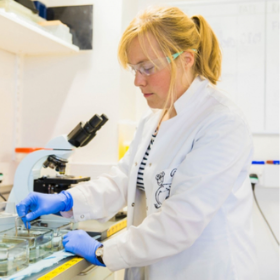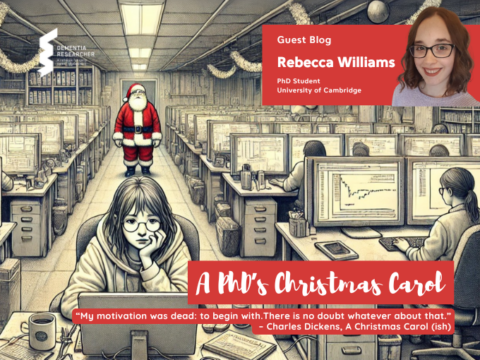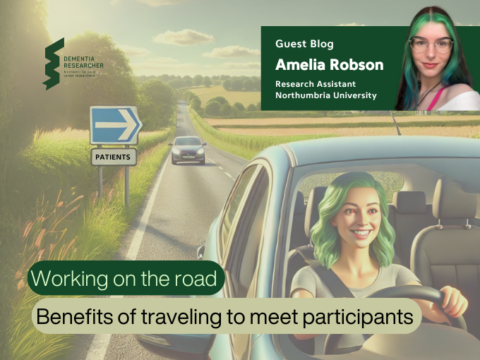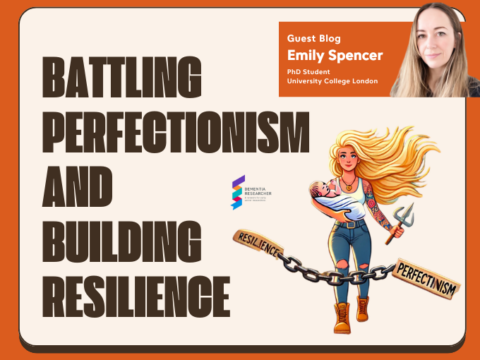Today we’re going to talk about my midlife crisis and why there’s nothing that can be done about it.
For those of you who have yet to realise it, I’m a big fan of the Freakonomics network of podcasts. I know absolutely nothing about economics but enjoy learning about everything from the potential of donut economies to the cost of public transport. And it’s relevant today because I am going to try and be an economist. Or at least I am going to try and talk to you about money and the state of science funding in the UK. It’s going to be long. And possibly boring.
As always, this was precipitated by a chat with someone. All my pieces are. Apparently, I don’t do any actual work I just natter with friends and colleagues about stuff. But this one was me telling a mentor that I felt like a bit of a failure and one of the reasons I felt that way was because, by my age, she had a lab of about eight people with several grants and students. I remember enjoying pictures of my other PhD supervisor’s office at my age because the lab had decided, as a prank for his birthday, to wrap every single object in his office in tinfoil.
I don’t have an office. I don’t even have a permanent job. Up until about two months ago I was due to be unemployed in a couple of weeks’ time. But I’ve done nothing different to them so why were they a success where I’ve been a failure?
This is where the mentor jumped in and said ‘No. You’ve not been a failure, it’s much harder now than it was then’.
She highlighted that she’d had people champion her at the right times, highlighted again that she’d been incredibly lucky but also just said that it’s generally harder than it was. I mentioned it to a friend who’s a couple of years ahead and she said that of course it was harder now, everything is about three times more expensive and there were loads more people than there used to be competing for money that doesn’t go nearly as far.
I wanted to check that blasé statement and that’s where the economics comes in. We’re going to attempt a deep dive into scientific finances and how far they stretch. For the sake of everyone’s sanity I have picked three years to focus on: 2000, 2010 and 2020. We’re going to look at how much stuff costs and costed, how many scientists there were and are, how much people got paid throughout those times, how much they asked for and what they did with the money.
Let’s start with some basic numbers. According to a variety of random reports that I trawled through from various higher ed institutions there is a general upward trend in the number of people doing PhDs in the UK across the time periods I’ve selected. In 2000 there were approximately 13k graduating with a PhD, in 2010 it was closer to around 38k and in 2020 it was closer to 44k. The lag in the last few years seems to be entirely because of a combination of the pandemic and Brexit. Countries like Germany and Canada are attracting more students than us now because they’re just as easy to get to, the courses are just as good and often the lifestyle and funding are better. But irrespective we’ve still got to try and fund three times as many PhD students as we did 20 years ago.
And what do these students cost to run? Way back in 2000, or so I am told by colleagues who were post-docing around then, you could easily run a PhD student off odds and ends of existing grants, simply because science was not as expensive as it is now and because everyone wasn’t trying to single-cell sequence everything. In 2010 you could get a grant to get a PhD student. In fact, I applied for a grant to become a PhD student around that time and found there was quite a wide array of places I could have written to for funding. Now, PhD students are allocated by local doctoral training centres. The doctoral training program for Oxford run by the BBSRC, for example, has around 40 students, the MRC one has around 22. At this point your job is now not to advertise a role and recruit, but to advertise yourself and your lab and your research and hope someone likes you enough to want to join your lab. I can hear you saying ‘aren’t they the same though?’. And on paper yes, they appear to be the same. But when you’re in a large institution if you’re not visible and making noise about your research then nobody knows about you, especially not busy doctoral students. But if you teach them, then suddenly you are on their radar and you become much more popular as a destination lab. Which means, as with so many of my previous posts, the small, new ECR labs will struggle to recruit students unless they sit within the auspices of a big, shiny person.
If we choose to stay in academia after our PhDs then we become post-docs. I could not find total post-docs for the UK so I went local and had some lovely admin guys dig out the numbers. I defined post-docs as being grades 7-9 in the UK. In the early 2000s there were around 800 of these researchers, in the mid-2000s there were more than double that – around 1900, and closer to now we’ve stayed roughly stable, dropping off by about 500 people. I suspect the late drop is a combination, again, of pandemic, Brexit and the great academic abandonment. But either way, we’ve got over twice as many people as we had to support twenty years ago. Those post-docs were paid roughly in line with inflation it turns out, so in 2000 the average starting salary was about 22k, in 2010 it was 27k and in 2020 it was about 32k. It should be noted that this salary is still relatively low. Starting salaries currently in the USA and Australia are around £10k more annually so if you’re thinking about your first post-doc, emigrate now whilst you still can.
So, we’ve established that there are three times as many people, two times as many post docs, and that they all cost almost double what they did ten to twenty years ago, but are people asking for more money?
For this I trawled through the UKRI funding database as well as asking a local PI who’s been gathering grants since the mid-90s. The UKRI database was enlightening but a little short. As I did with the post-docs I made it local and just looked at grants awarded to Oxford because otherwise the spreadsheet was huge. About eight or so years ago, the median funding requested was about £450k. About a year ago the median funding requested was about £450k. The average is slightly higher recently but it’s pulled by a couple of really big grants and a couple of oddly small ones. My local PI had an interesting list of research funding where he had three-year project grants from almost twenty years ago at the same cost as three-year project grants from 2019 – both about £200k. He stressed they were potentially not to do the same sort of work but also agreed that the money didn’t seem to go as far.

Fundamental science isn’t the only field of research thats increased in cost. Clinical trials, a critical phase in drug development, have seen substantial cost increases over the past few decades. According to the Tuft Center for the Study of Drug Development, the costs of clinical trials for drug development increased five times faster than preclinical costs from the 1980s to the 1990s.
So in terms of what we’re doing with it, is it any different? Let’s start with the basics and think about the sort of science we do now compared to the sort of science we did twenty years ago. Because of the drive to publish more and better and shinier papers there is a consequent drive for more and better and shinier technologies. Over the last twenty years the two that could be considered to have had the most impact on the cost of research are the use of transgenic animals and the use of ‘omics techniques. The use of transgenic animals can run into the tens of thousands a month, and the running of single cell sequencing, for example, can also be many thousands. So, if I want to employ a post-doc who is going to expand a new colony of mice and single-cell sequence a few bits of their brain for three years I have already run my budget to probably somewhere close to half a million. To essentially do one large experiment. I am going to risk my neck and question whether that’s a good use of funds.
But let’s assume you’ve got a grant for you and a post-doc to exist for three years, there’s also the increasing and exceedingly variable cost of overheads to deal with. These are variable by institution and are applied to grants to do things like pay your finance officers and keep your lights on. The technical term for this is QR funding, and it can come from charities, industries or from funding bodies. A large institution in the UK, like one of the London Universities, can easily go through £140 million of this in a year. (Is it any wonder they can’t afford to keep you on permanently?) But in real terms, QR funding is also falling, with Stephanie Smith, a Russell Group analyst, showing the numbers are down around 13% over the last 10 years.
And all of this – the cost of things and people and space – is not even beginning to take into account the soft bits of science – the cost of publishing and the cost of conferences and the cost of training courses. If you want to publish a single, gold open-access Nature paper you’ll lose up to £9k in publishing charges, potentially almost 5% of your total science budget if you’re on a £200k grant. It can cost up to that much to send a couple of post-docs to a European conference with registration fees and travel and accommodation. If somehow your two post-docs managed to make a Nature paper (they need big teams now so it’s unlikely) and wanted to take it to a conference that’s 10% of your budget suddenly gone. But on the upside, you have one of those coveted Nature papers, right?
The upshot of all of this is that you, your students and your science all cost more than they used to but there hasn’t been a really significant increase in the amount we’re asking for. This means that instead of working in institutions making new exciting discoveries, we’re instead running the equivalent of the academic potato peel pie society and trying to stretch our leftovers into experiments. Which is not something our forebears had to do twenty or even ten years ago. And going forward I’m not sure how long that attitude is sustainable, and how competitive that will keep UK science and industry.

Dr Yvonne Couch
Author
Dr Yvonne Couch is an Alzheimer’s Research UK Fellow at the University of Oxford. Yvonne studies the role of extracellular vesicles and their role in changing the function of the vasculature after stroke, aiming to discover why the prevalence of dementia after stroke is three times higher than the average. It is her passion for problem solving and love of science that drives her, in advancing our knowledge of disease. Yvonne shares her opinions, talks about science and explores different careers topics in her monthly blogs – she does a great job of narrating too.

 Print This Post
Print This Post






